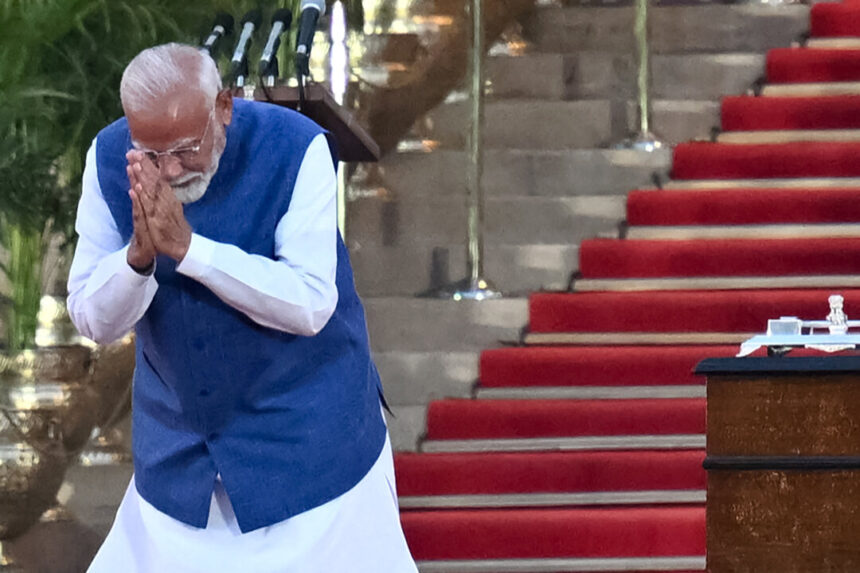Examining Mr. Modi’s beginning of a third term through the perspective of New Delhi’s Prime Ministers Museum, it is evident that his brand has enhanced the authority of the position, according to observers.
News Analysis
In the capital city of India, the Prime Ministers Museum attracted a continuous flow of visitors on a Sunday morning. This museum, equipped with state-of-the-art technology, pays tribute to the lives, visions, and work of India’s 15 prime ministers post-independence, starting from Jawaharlal Nehru and concluding with Narendra Modi, who was first elected in 2014 and sworn in for a rare third term at India’s presidential palace on the same day. The museum offers a unique perspective on the prime minister’s office as Mr. Modi embarks on his role once again.
Situated in the former residence of Nehru, Teen Murti Bhavan, the museum welcomed seven heads of state who attended Mr. Modi’s swearing-in ceremony. Accompanied by 9,000 guests, including foreign dignitaries, celebrities, and corporate leaders, the event took place just minutes away from the museum. The surrounding Lutyens’ Delhi area, home to key government establishments like the Indian parliament and the presidential palace, was adorned with large banners celebrating Modi’s re-election for a third term and applauding him as “the creator of Modern India.”
Inside the museum, the digitally-focused pavilion dedicated to Narendra Modi delves into the “Modi Doctrine” and sheds light on his policies in India’s neighboring countries, cultural diplomacy, security initiatives, life, and accomplishments. Additionally, a VR helicopter ride on the same floor offers a 3D virtual tour of significant infrastructure projects along India’s borders, available with an add-on ticket.
Prior to Mr. Modi’s third swearing-in, Nehru was the sole prime minister in Indian history to serve three consecutive terms. Interestingly, Nehru’s party, the Indian National Congress (INC), now leads the opposition alliance against the National Democratic Alliance (NDA) under Mr. Modi’s leadership.
Upon Mr. Modi’s inauguration in the presence of India’s President Droupadi Murmu at the Rashtrapati Bhavan, he achieved a feat comparable to Nehru’s hat trick six decades after Nehru’s passing. However, the ever-evolving nature of India’s electoral democracy, particularly with the pivotal prime minister’s role, presents Mr. Modi with a more robust opposition than Nehru faced, spearheaded by the INC, whose performance in the 2024 elections was one of its weakest to date.
During his initial two terms, Mr. Modi presided over a period of unprecedented growth for India. Analysts believe that his first decade in office amplified the authority of the prime minister’s office. The question now remains on how his power and influence will evolve during his third term.
Michael Kugelman, director of the South Asia Institute at the Wilson Center in Washington, asserts that Mr. Modi’s dominant political persona has elevated the power and prestige of the prime minister’s office in India.
“I would argue that in the Modi era, the office of the prime minister and the institution of the prime ministership has become even more powerful simply because of Modi himself, his popularity, and influence,” he stated.
Mumin Chen, a political science professor at Taiwan’s Chung Hsing University and a former diplomat in New Delhi, emphasizes that in his third term, Mr. Modi’s administration must be innovative and daring in implementing economic reforms. Mr. Chen highlights the need for strategies to enhance the domestic business environment and attract foreign investments, especially with investors shifting away from China.
Neeraj Singh Manhas, a special advisor for South Asia at the Parley Policy Initiative in South Korea, points out Mr. Modi’s swift action after commencing his third term.
“Just a day after assuming office for his third term, PM Modi approved the PM Kisan Nidhi scheme for the welfare of 93 million farmers, allocating $2.4 billion. This quick decision showcases his dedication to addressing domestic welfare from the onset,” Mr. Manhas mentioned. The PM Kisan Nidhi program aims to benefit India’s agricultural families.
‘Centrality’ of Prime Minister’s Office Strengthened
Observers of India believe that Mr. Modi’s influence has bolstered the “centrality” of the prime minister’s office, which holds a paramount position in the Indian governance structure.
Harsh V. Pant, the vice president of studies and foreign policy at the Observer Research Foundation in New Delhi and a professor of international relations at King’s College London, emphasizes the significant role of the prime minister’s office in India’s governance system. During a phone conversation with The Epoch Times, Mr. Pant emphasized the significant role of the prime minister’s office in the Indian government structure. A visit to the Prime Ministers Museum showcases how each prime minister has brought a unique approach to governing a diverse nation like India, with its myriad languages, tribes, and religions. Mr. Pant highlighted that Mr. Modi has restored the power and centrality of the prime minister’s office, deviating from the constraints of previous coalition governments.
Mr. Modi’s focus on development and growth has been a consistent theme throughout his tenure, as evidenced by his speeches and actions. While his third term saw him needing to form a government with the support of alliance partners due to falling short of a majority, analysts like Mr. Kugelman believe that Mr. Modi’s power remains strong despite this. The evolving political landscape in India will shape how Mr. Modi governs and how the prime minister’s office adapts to the current coalition government.
Challenges lie ahead for Mr. Modi, especially in the realm of national security with neighboring countries like China and Pakistan. The recent joint statement from Pakistan and China opposing unilateral actions in South Asia, along with a terror attack in Jammu and Kashmir, underscore the complex geopolitical environment in which Mr. Modi operates. Despite criticism from opponents, Mr. Modi’s commitment to democracy and development remains a central pillar of his leadership. On June 9, just before Prime Minister Narendra Modi was sworn in for his third term, a bus carrying Hindu pilgrims was ambushed by gunmen, resulting in the death of nine individuals in one of the deadliest recent attacks on civilians (Rakesh Bakshi/AFP via Getty Images).
According to Mr. Pant, these incidents are likely connected to Mr. Modi’s inauguration, and he anticipates that Pakistan and China will collaborate in their actions moving forward. He suggests that Pakistan will engage in further provocative actions to maintain relevance in the Kashmir discourse.
Mr. Manhas believes that the attack on pilgrims, occurring simultaneously with Mr. Modi’s swearing-in ceremony, was intended to disrupt the sense of security and stability in India during a critical political moment. This act challenges the new administration’s national security policies and tests their determination.
The joint statement issued by China and Pakistan, timed alongside Mr. Modi’s inauguration and the attack, will place pressure on the prime minister regarding his Kashmir policies, particularly following a significant increase in voter turnout in the region.
The coordination between China and Pakistan in these circumstances aims to challenge India’s sovereignty and policy decisions in Kashmir, signaling their stance on the international stage to the new Indian government. These coordinated efforts highlight the complexities and geopolitical tensions in the South Asian region. Please rephrase this sentence.
Source link





